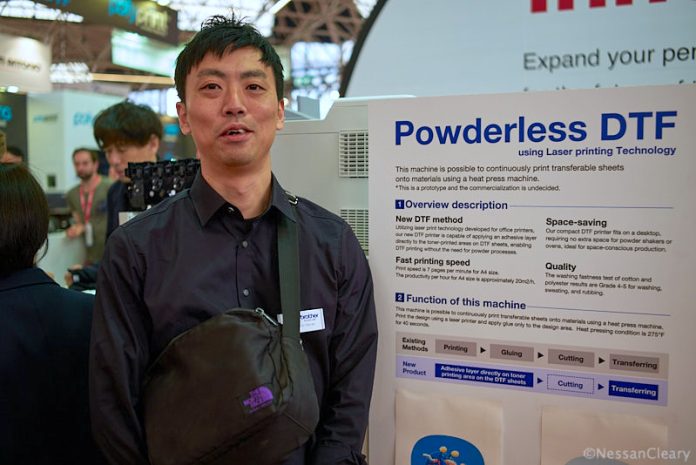That’s because Brother’s solution uses dry toner instead of inkjet. The company has adapted an existing office laser printer, adding an adhesive unit to it. For now this just a prototype and it will only take A4 paper.
It relies on using a coated transfer paper, which differs from existing transfer papers and for now is only available through Brother. So it’s perhaps more accurate to call it a Direct-to-paper approach.
This paper is fed into the printer, which prints the image to it, using the existing CMYK toners, and then through the fusing unit. From there, the printer applies a glue layer to the print, which is then dried. After that the image can be applied to a fabric via a heat press, as with any other DtF system.
It’s reasonably fast, producing seven A4 pages per minute, which is a lot quicker than most DtF machines as there’s no need to apply and cure any powder. It’s also a more compact unit, again because there’s no powder shaker.
The main drawback for now is that there’s no white as Brother does not have any white toner, which means that the results are not as good on dark materials. However, there’s no technical reason for this, just that there’s no need for white in an office printer that’s going to be used exclusively for printing to white paper. So Brother can either develop its own white toner or license this from another vendor.
Oki, for example, also has a similar solution, complete with white toner, but with the printing and gluing in separate devices. Brother’s integrated approach is neater, and of course, Brother has a much bigger footprint in the DtG/ F market
Masahiro Haruki from Brother’s business development group, says, “The feedback so far is that the A4 size is too small and that we need to implement the white toner for the black shirts.”
Haruki says that Brother has not yet decided on the price, but that it will be much cheaper “because we are just using an existing laser printer.” He says that it should be commercially available at some point next year, adding, “We will decide the specification after the show.”

Elsewhere on the Brother stand I came across a model of an automated factory. Nijika Hayashi, product planning specialist within Brother’s Industrial Printing Business, says that the main advantage is that it only needs one operator and can produce up to 180 items per hour.
The system is set up as a 20 meter long production line with the operator at one end loading the garments, which are then transported automatically through the various stages. The first step is to apply pretreatment, which is by followed by a drying station. Then the garments move to the printing where there is a line of up to four of Brother’s proven GTX600 DtG printers. From this the garments loop back, through a final drying station and back to the starting point for the operator to unload them.
Hayashi says that having multiple printers gives an advantage over some automated machines because customers can still produce orders if one machine is down for maintenance. There’s an option to have either two or four printers but no more as one operator wouldn’t be able to handle any more output.
For now, Brother is only selling this system in the US but has already installed 19 since launching it last Spring. Hayashi says that the system costs less than US$ 1 million, adding, “We are still deciding whether or not to bring it to Europe.”
In the meantime, you can find further information on Brother’s garment printing solutions from garmentprinter.global.brother.
First published by Printing and Manufacturing Journal on 20 March 2024. Republished by permission.
















